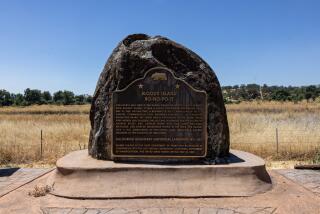Simi’s Bottle Village May Go on Auction Block
- Share via
SIMI VALLEY — The bell has not yet tolled for Grandma Prisbrey’s Bottle Village, but a delinquent-tax bill of more than $11,000 may put the folk-art landmark on the auction block shortly after New Year’s.
Owned by a nonprofit preservation group, the quirky site was named a county landmark in 1979 and earned a spot on the National Register of Historic Places in 1996.
But those honors could provide scant protection for the collection of 13 structures and 22 sculptures that Tressa “Grandma” Prisbrey fashioned from hundreds of thousands of bottles, dolls’ heads, car headlights, TV tubes and myriad oddments.
“The bottom line is that a new owner could bulldoze it, but getting there through the county’s landmark procedures might cause some delays,” said Kim Hocking, staff consultant to the county’s Cultural Heritage Board.
Prisbrey, a free spirit from North Dakota who loved to show off her huge collection of commemorative pencils as well as her constantly evolving village, died in 1988 at age 91. It took her a quarter of a century and countless trips to the dump to build her “village,” which has been recognized in numerous displays and scholarly works on folk art.
Her property--a third of an acre dotted with wishing wells, shrines and its own Leaning Tower--is owned by a volunteer group called the Preserve Bottle Village Committee. Damaged by the Northridge earthquake, the landmark is open only by appointment.
Daniel Paul, a spokesman for the group, said members are trying to raise money. For two years, they have sold $10 “deeds” to Bottle Village by the square foot. They are also offering Prisbrey’s 24-page booklet on her life, her art and such trivia as the effect of food coloring on cats.
More significantly, the group is holding discussions with prospective donors, said Paul, a 26-year-old waiter who has put off plans to attend graduate school in art so he could help save Bottle Village.
“We’d like to get Bottle Village into the position of being open and being shared,” he said. “When we have visitors, they almost always come away liking it.”
The landmark’s current troubles started when property taxes for 1989 went unpaid, said John McKinney, the county’s assistant treasurer-tax collector.
He said no taxes have been paid since, although Paul contended that the committee has made its payments in recent years.
Whatever the case, the county is allowed to seize properties and auction them off after five years of tax delinquency. Bottle Village was to be sold for taxes in 1994, but the earthquake damage bought the village an extension until 1999.
If the full tax bill of $11,176 is not paid by Jan. 31, Bottle Village will be auctioned off at the County Government Center on Feb. 24, McKinney said.
“Landmark status makes no difference to the tax and revenue code of the state of California,” he said.
But it could make a difference to anyone seeking to develop the property, which sits on Cochran Street, one of Simi Valley’s main thoroughfares.
To alter or demolish a county landmark, its owner must obtain permission from the Cultural Heritage Board, Hocking said.
If the board denies the request, it can forestall any action on the site for six months. During that period, county officials would encourage the owner to explore ways to save the landmark--such as moving it or finding another buyer.
But if no solution is found after six months, the owner can tear the village down, Hocking said.
Even being in the National Register of Historic Places doesn’t help much, according to Marilyn Lortie, a historian with the state Office of Historic Preservation.
She said her office would become involved only if a federal agency or a group using federal money were to buy Bottle Village and try to raze it.
Federal money has already eluded the Preserve Bottle Village Committee once.
After the 1994 earthquake, Rep. Elton Gallegly (R-Simi Valley) scuttled a federal rehabilitation grant for nearly $500,000.
The FEMA grant would have been “a monstrous waste of public funds” on “a collection of trash,” fumed Gallegly, a former mayor of Simi Valley.
Such sentiments frustrate preservationists like Paul of the Preserve Bottle Village Committee.
“Tressa Prisbrey didn’t mean to get anyone upset by using items from the dump,” he said. “She had the urge to create, and couldn’t afford traditional building materials. She didn’t see herself as obligated to not create because she didn’t have money.”
More to Read
The biggest entertainment stories
Get our big stories about Hollywood, film, television, music, arts, culture and more right in your inbox as soon as they publish.
You may occasionally receive promotional content from the Los Angeles Times.











